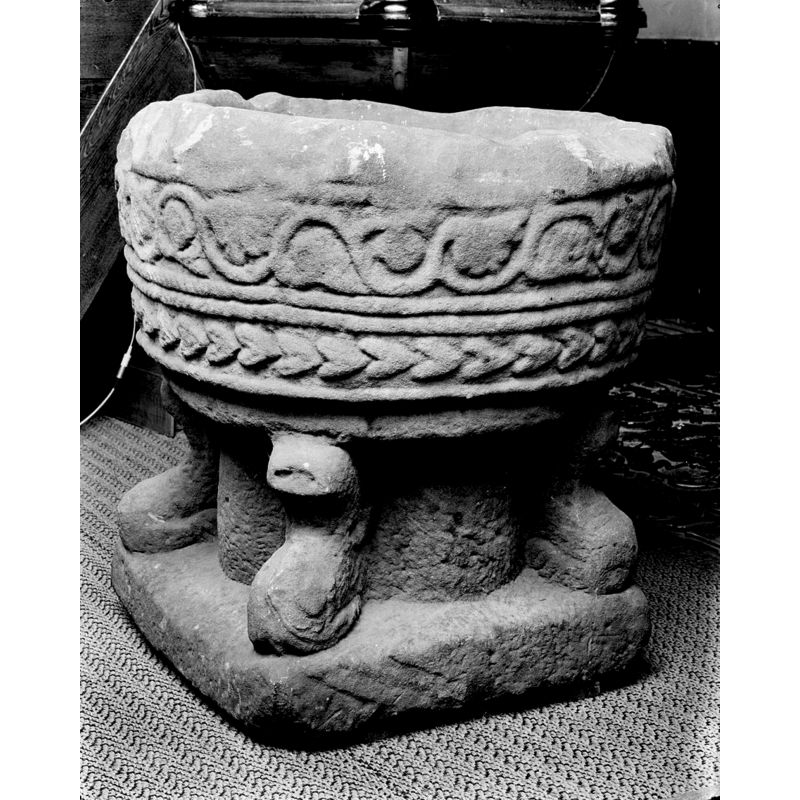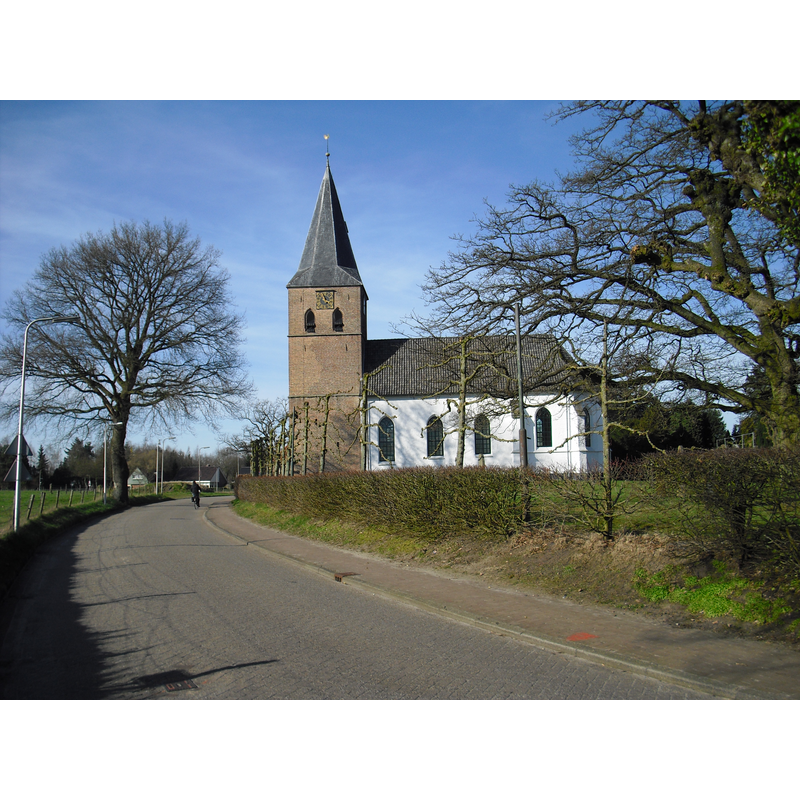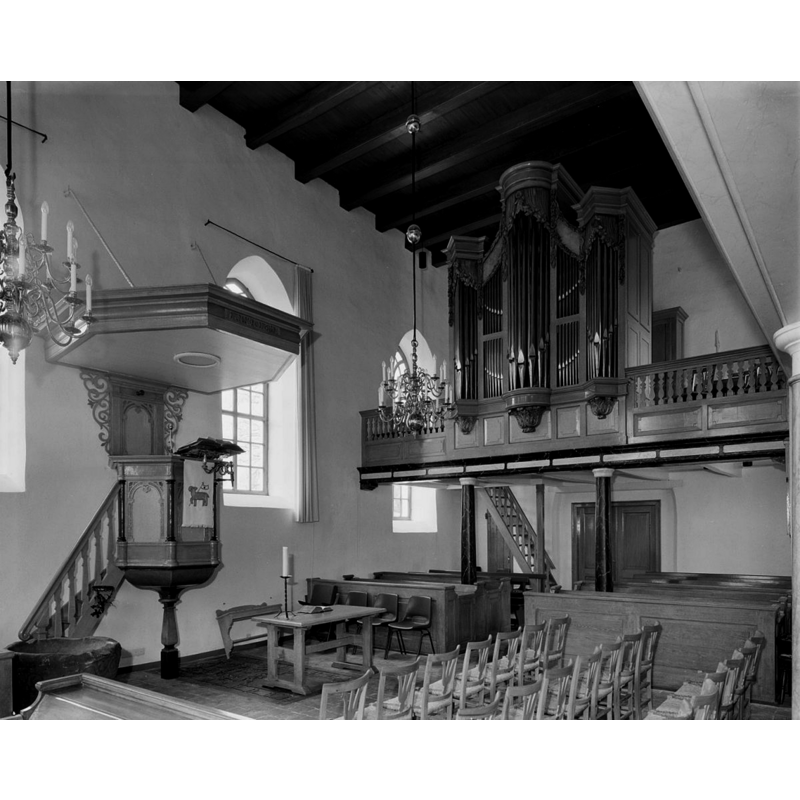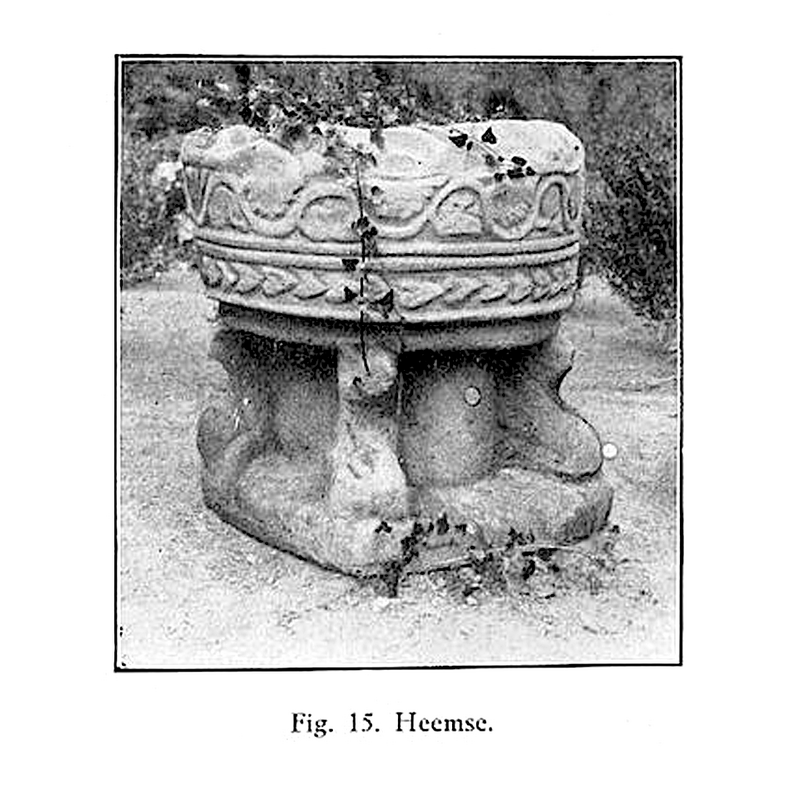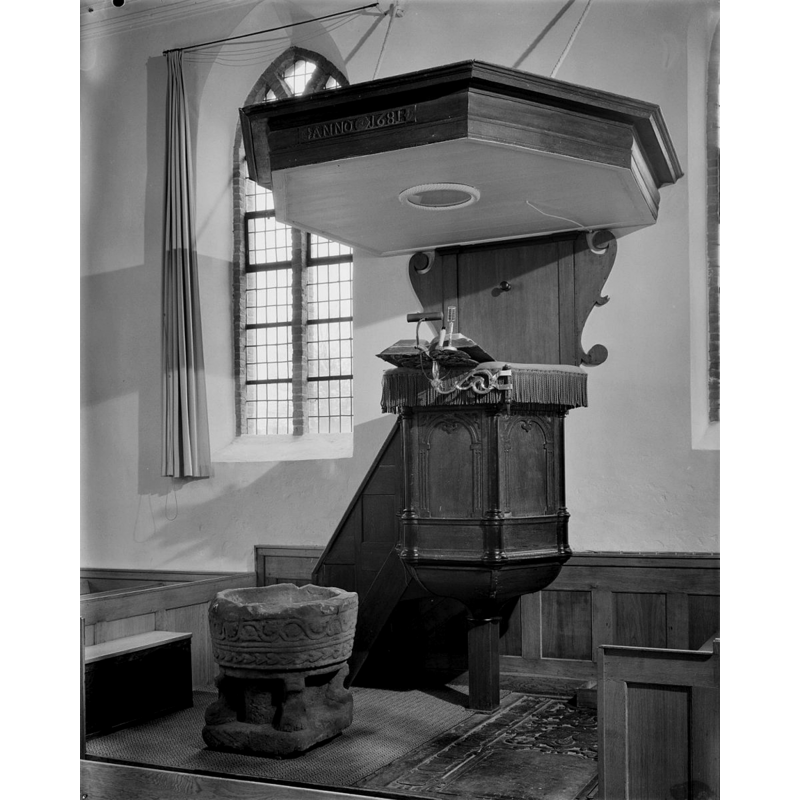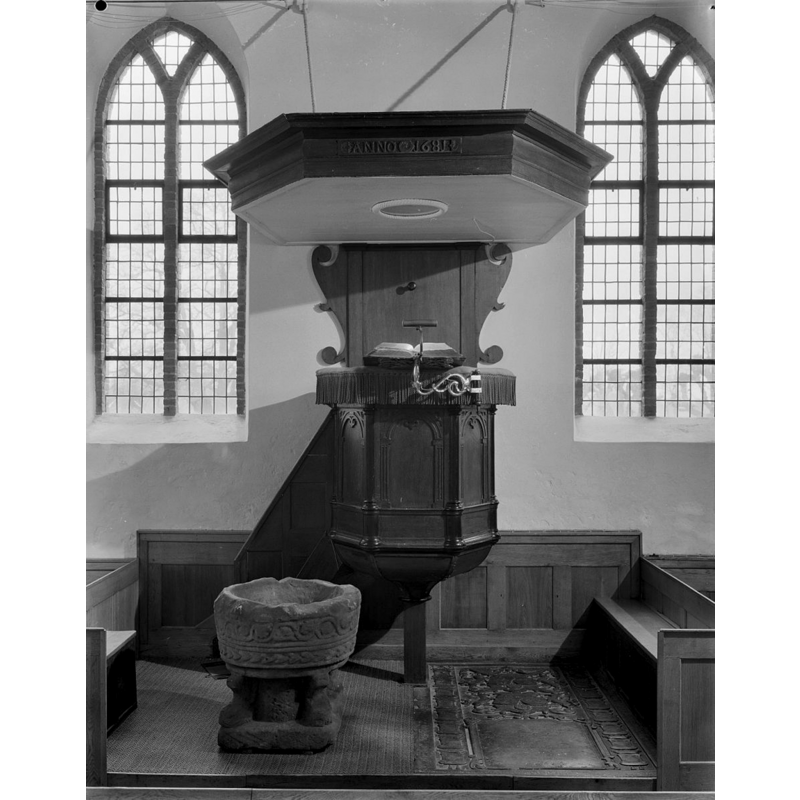Heemse / Heymis / Hiemse
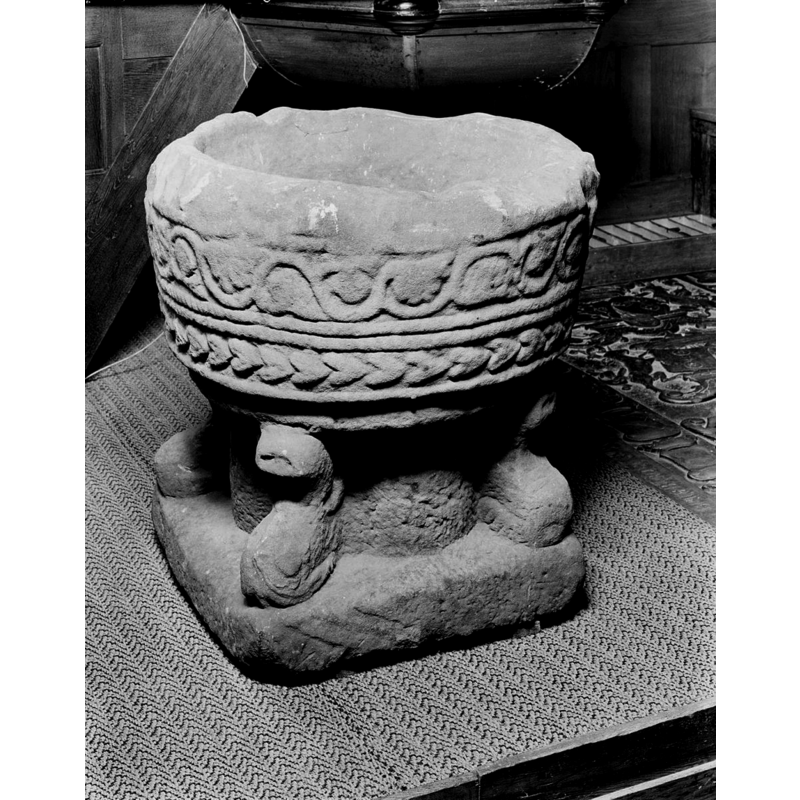
Image copyright © Rijksdienst voor het Cultureel Erfgoed, 2015
CC-BY-SA-3.0-NL
Results: 11 records
animal - mammal - lion - sejant-gardant - 4
Scene Description: very stylised
Copyright Statement: Image copyright © Rijksdienst voor het Cultureel Erfgoed, 2015
Image Source: B&W phototograph taken February 1971 by A.J. (Ton) van der Wal, in the Rijksdienst voor het Cultureel Erfgoed [https://commons.wikimedia.org/wiki/File:Romaans_doopvont_-_Heemse_-_20104212_-_RCE.jpg] [accessed 5 December 2015]
Copyright Instructions: CC-BY-SA-3.0-NL
design element - motifs - heart-shaped on its side
Scene Description: a band of into a pattern that resembles a stylised braid
Copyright Statement: Image copyright © Rijksdienst voor het Cultureel Erfgoed, 2015
Image Source: B&W phototograph taken February 1971 by A.J. (Ton) van der Wal, in the Rijksdienst voor het Cultureel Erfgoed [https://commons.wikimedia.org/wiki/File:Romaans_doopvont_-_Heemse_-_20104212_-_RCE.jpg] [accessed 5 December 2015]
Copyright Instructions: CC-BY-SA-3.0-NL
design element - motifs - moulding
Copyright Statement: Image copyright © Rijksdienst voor het Cultureel Erfgoed, 2015
Image Source: B&W phototograph taken February 1971 by A.J. (Ton) van der Wal, in the Rijksdienst voor het Cultureel Erfgoed [https://commons.wikimedia.org/wiki/File:Romaans_doopvont_-_Heemse_-_20104212_-_RCE.jpg] [accessed 5 December 2015]
Copyright Instructions: CC-BY-SA-3.0-NL
design element - motifs - roll moulding - parallel - 2
Copyright Statement: Image copyright © Rijksdienst voor het Cultureel Erfgoed, 2015
Image Source: B&W phototograph taken February 1971 by A.J. (Ton) van der Wal, in the Rijksdienst voor het Cultureel Erfgoed [https://commons.wikimedia.org/wiki/File:Romaans_doopvont_-_Heemse_-_20104212_-_RCE.jpg] [accessed 5 December 2015]
Copyright Instructions: CC-BY-SA-3.0-NL
design element - motifs - vine - acanthus?
Copyright Statement: Image copyright © Rijksdienst voor het Cultureel Erfgoed, 2015
Image Source: B&W phototograph taken February 1971 by A.J. (Ton) van der Wal, in the Rijksdienst voor het Cultureel Erfgoed [https://commons.wikimedia.org/wiki/File:Romaans_doopvont_-_Heemse_-_20104212_-_RCE.jpg] [accessed 5 December 2015]
Copyright Instructions: CC-BY-SA-3.0-NL
view of church exterior - south view
view of church interior - nave - looking southwest
Scene Description: the old font is partially visible in the foreground, left side
Copyright Statement: Image copyright © Rijksdienst voor het Cultureel Erfgoed, 2015
Image Source: B&W phototograph taken January 1978 by A.J. (Ton) van der Wal, in the Rijksdienst voor het Cultureel Erfgoed [https://commons.wikimedia.org/wiki/File:Preekstoel_en_orgel_-_Heemse_-_20104249_-_RCE.jpg] [accessed 5 December 2015]
Copyright Instructions: CC-BY-SA-3.0-NL
view of font
Copyright Statement: Image copyright © Rijksdienst voor het Cultureel Erfgoed, 2015
Image Source: B&W phototograph taken February 1971 by A.J. (Ton) van der Wal, in the Rijksdienst voor het Cultureel Erfgoed [https://commons.wikimedia.org/wiki/File:Romaans_doopvont_-_Heemse_-_20104217_-_RCE.jpg] [accessed 5 December 2015]
Copyright Instructions: CC-BY-SA-3.0-NL
view of font in context
view of font in context
Scene Description: the font is located by the pulpit, a common placement in the Reformed churches of the Netherlands
Copyright Statement: Image copyright © Rijksdienst voor het Cultureel Erfgoed, 2015
Image Source: B&W phototograph taken February 1971 by A.J. (Ton) van der Wal, in the Rijksdienst voor het Cultureel Erfgoed [https://commons.wikimedia.org/wiki/File:Preekstoel_-_Heemse_-_20104213_-_RCE.jpg] [accessed 5 December 2015]
Copyright Instructions: CC-BY-SA-3.0-NL
view of font in context
Scene Description: the font is located by the pulpit, a common placement in the Reformed churches of the Netherlands
Copyright Statement: Image copyright © Rijksdienst voor het Cultureel Erfgoed, 2015
Image Source: B&W phototograph taken February 1971 by A.J. (Ton) van der Wal, in the Rijksdienst voor het Cultureel Erfgoed [https://commons.wikimedia.org/wiki/File:Preekstoel_-_Heemse_-_20104216_-_RCE.jpg] [accessed 5 December 2015]
Copyright Instructions: CC-BY-SA-3.0-NL
INFORMATION
FontID: 20198HEE
Object Type: Baptismal Font1
Church/Chapel: Sint-Lambertuskerk / Sint-Lambertuskarke
Church Patron Saints: St. Lambert of Maastricht[aka Lambaert, Lambertus, Lambrecht, Landebertus]
Church Location: Scholtensdijk 24, 7771 CV Hardenberg, Netherlands -- Tel.: +31 523 266 744
Country Name: Netherlands
Location: Overijssel
Directions to Site: Located S of the N34, in the municipality of Hardenberg
Font Location in Church: Inside the church, in the nave, by the pulpit
Century and Period: 13th century, Late Romanesque
Workshop/Group/Artisan: Bentheim font?
Church Notes: first Christian church here said to have been founded in the mid-8thC by missionaries Lebuinus and Marcellinus on or near the site of a pagan sacrificial site; wooden church ca. 1200, re-built in stone in the 15thC
Font Notes:
Click to view
Eyck (1846) mentions early fonts at Oldenzaal, Heemse, Loosduinen and Schokland, that are now lost [NB: he was probably referring to the font from the 8th-century church here]. Ortt van Schonauwen (1858) mentions a Bentheim font from this church having been for a long time used as a water-trough in the rectory garden. Listed with measurements in Ligtenberg (1915) as a sandstone baptismal font of the Romanesque period. A font here is noted in Drake (2002) as having a variant type of heart motif from others in the Bentheim School. The font, which is very worn around the upper rim, as well as on the sides, consists of the quasi-cylindrical tub-shaped basin typical of many Bentheim fonts of the period, the sides decorated with a running vine, a plain double rol moulding below, and a pattern of heart-like motifs below; this latter element is what Drake [cf. supra] points out as a variation; it resembles a chain of hearts on their sides, each pointed tip fitting into the opening of the next one; one could suggest that it is a stylised form of the braid or double-rope pattern so common in many of the Bentheims; does this stylising oof an earlier motif make it a later work? The base is more traditional within the types of Bentheim fonts, four stylised lions at 90-degree angles from a cylindrical stem, on a quadrangular lower base. No cover present.
COORDINATES
Church Latitude & Longitude Decimal: 52.569491, 6.601444
Church Latitude & Longitude DMS: 52° 34′ 10.17″ N, 6° 36′ 5.2″ E
UTM: 32U 337448 5827084
MEDIUM AND MEASUREMENTS
Material: stone, sandstone (Bentheim)
Font Shape: cylindrical (mounted)
Basin Interior Shape: round
Basin Exterior Shape: round
Drainage Notes: no lining
Diameter (includes rim): 85 cm*
Basin Total Height: 39 cm*
Font Height (less Plinth): 86 cm*
Notes on Measurements: * Ligtenberg (1915: 163) [NB: Ligtenberg notes he was unable to measure the depth of the basin as it was filled with soil and flowers]
REFERENCES
Drake, Colin Stuart, The Romanesque Fonts of Northern Europe and Scandinavia, Woodbridge, Suffolk: Boydell Press, 2002
Eyck [Eijck], Frans Nicolaas Marius, "Kort begrip omtrent de oude doopvonten in ons land door Mr FN Eijck tot Zuylichem", Erste deel, Erste Aftevering, Berigten van het Historisch Gezelschap te Utrecht, 1846, pp. 223-228; p. 228
Ligtenberg, Raphael, "Romaansche doopvonten in Nederland: De hardsteenen vonten", VIII, 2 [Tweede serie], Bulletin van den Nederlandschen Oudheidkundigen Bond, 1915, pp. 154-190, 236-252; p. 163
Ortt van Schonauwen, J., "Oude Doopvonten", Vierde Deel, Derde Serie, Kronijk van het Historisch Genootschap Gevestigd te Utrecht, 1858, pp. 143-152; p. 150
